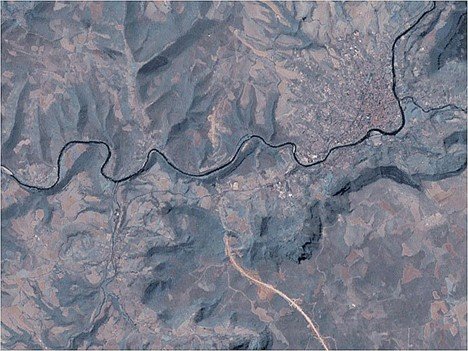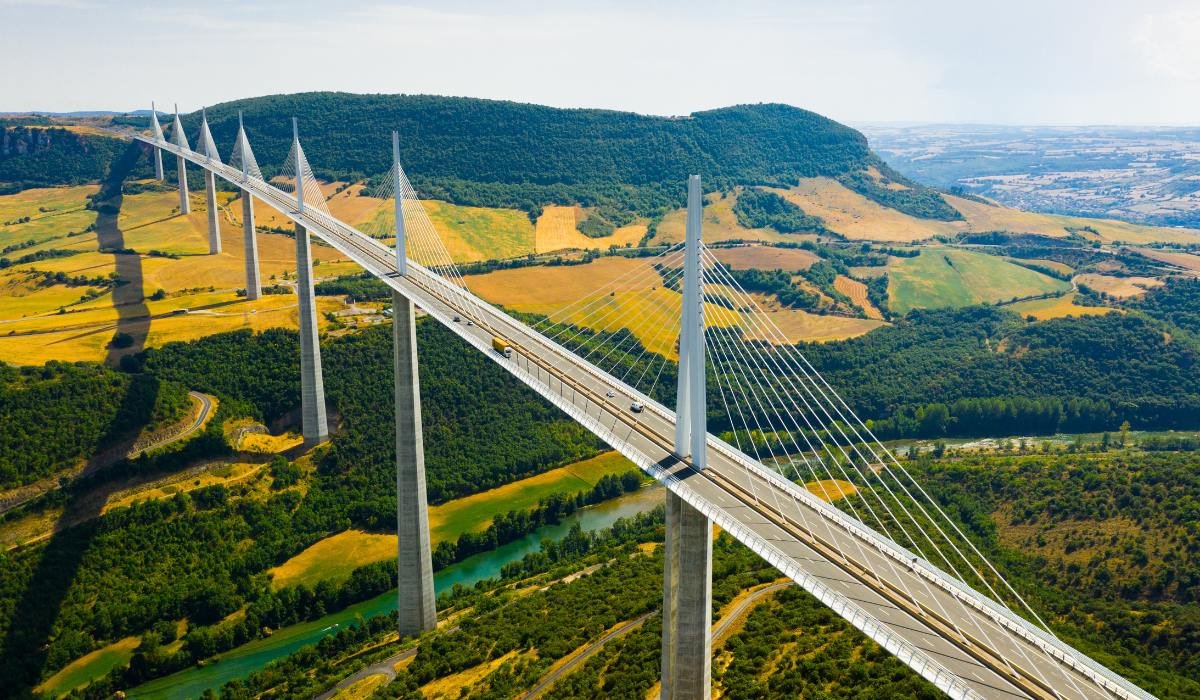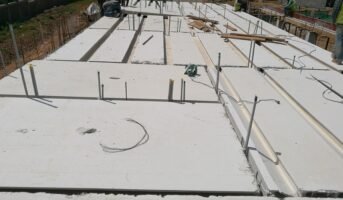The Millau Viaduct is a cable bridge with support at both ends and multiple supports in between. It was completed in 2004 and is built across the gorge valley of the Tran near the west of Millau. In September 2020, Millau Viaduct was named the highest bridge globally, having a structural height of 336.4. The bridge has some unique characteristics apart from its height. The total length of the bridge is 2460 metres with a width of 32.05 metres with a design life of 120 years.
This bridge was designed by famous engineers Michel Virlogeux and Norman Foster, who were English architects. While the construction of this bridge was done by Compagnie Eiffage du Viaduc de Millau and is also maintained by them only. On 16 October 2001, 21 years ago, the construction of this fine link was started. The bridge was finally inaugurated on December 14 2004 and came to use on December 16 of that same year. The construction of this longest viaduct cost approximately 424 million dollars.
The Millau Viaduct is an autoroute axis that goes from Paris to Beziers and Montpellier. The bridge is claimed to be one of the marvellous achievements of modern engineering. The Millau Viaduct was even awarded by the International Association for Bridge and Structural Engineering in the year 2006.
See also: Types of building materials
Millau Viaduct: History
The town of Millau remains jammed with cars every year due to the traffic that passes from Paris to Spain. People living in Millau were facing a problem due to this excessive traffic. The roads were becoming more congested, and the situation was worsening. There were discussions of different ideas to make the traffic under control.
The first idea was discussed in 1987 and then in 1991. After the discussion, the government of France held discussions with various architects and designers from the year 1993 to 2001. They came up with the plan of building a bridge over the Tarn river valley and even consulted the government of France for the same. The consultation was done for a long time till they came up with a perfect design.
Sogelerg Consortium gave a proposal regarding the bridge in 1996. He came up with the idea of a cable-stayed bridge that Michel Virlogeux and Norman Foster designed. The design idea was approved. The building process of the viaduct was started on October 16, 2001.
Initial pier construction began in January 2002 and was completed in November 2003. The bridge was opened on December 16, 2004, 25 days ahead of schedule. Roadways were completed in May 2004, pylons and shrouds in the second half of 2004, and the viaduct. During the inaugural ceremony, President Jacques Chirac officially opened the bridge.
This bridge broke many records. It has the highest bridge tower in the world (343 metres), Europe’s highest road bridge deck, and the highest electrical structure in the world (245 metres and 221 metres) (270 metres).
The total weight of the metal deck is about 36,000 tons, the length is 2,460 metres, and the width is 32 metres. The six central spans are 342 metres long, and the two outer spans are 204 metres. Each of the seven masts is 87 metres high and weighs 700 tons. Each has 11 fixed cables (passageways) that support the road deck.
Depending on the length, each strut consists of 55 to 91 high-strength steel strands. Each strand consists of 7 steel cables with triple protection against corrosion. The metal deck is clad in a modified bitumen that is strong enough to withstand road conditions yet flexible yet strong enough to adapt to deformations encountered in road traffic. The right formula was discovered after two years of experimentation.
The electrical installation of the viaduct consists of the following:
30 km high voltage cable, 20 km of fibre optics, 10km of low-voltage cables and 357 telephone sockets allow workers to be in touch with each other and the command post. Masts, decks, pylons, and stays are fitted with many instruments to monitor their condition and detect changes and wear resistance of the viaduct. All information collected by the equipment is analysed and sent to the toll booth. The toll booth is located 4 km north of the viaduct. The bridge toll booth and technical and commercial administration are housed there. The toll station has 16 lanes, eight in each direction. In light traffic, the central cab can serve both directions at the same time.
Millau Viaduct: Photos

Given above is the satellite image of the proposed route before construction of the Millau Viaduct bridge
Source: Wikimedia

Source: Pinterest
Millau Viaduct: Construction details
Two weeks after the cornerstone was installed on December 14, 2001, workers began digging a shaft for the piles. Four concrete poles support each pylon. Each stake is 15 metres (49 feet) deep and 5 metres (16 feet) in diameter to ensure the stability of the pylon. To increase the strength of the piles, a large base 3-5 metres (10-16 feet) thick was poured on top of the piles.
The 2,000 cubic metres (2,600 cubic yards) of concrete required for the foundation were poured simultaneously as the piles. After that, the speed of construction increased rapidly. Every three days, each pylon is extended by four metres (13 feet). This achievement is mainly due to the sliding form of work. A system of shoe anchors and fixed rails in the centre of the pylon allowed a new layer of concrete to be poured every 20 minutes.
Millau Viaduct: Discover the tallest cable-stayed bridge
Millau viaduct is the world’s tallest bridge, culminating at 343 metres (higher than the Eiffel tower), 2460 metres in length and touching the bottom of the Tarn valley in only nine places.
Piers have been construction with high performance concrete and pylons are the tallest elements, the tallest pylon at 244.96 metres 803.7 ft, produced and mounted by Paech Construction Enterprise from Poland.
Millau Viaduct: Launching
The road deck of the bridge was constructed on the plateaus at both ends of the viaduct and slid into the pylons using bridge launching techniques. Each half of the assembled road deck slid longitudinally from the plateau to the pylons, passing one pylon to the next. During the launch, the road deck was supported by eight temporary towers, but these were removed towards the end of construction.
In addition, the hydraulic jacks pushed the road deck in each plateau, each pylon had a mechanism attached to it that also pushed the deck. The mechanism consisted of a pair of computer-controlled wedges below the deck and operated hydraulically. The movement of the hydraulically operated wedges was done in the following sequence:
- The bottom wedge slides under the top wedge and lifts onto the pavement above while pushing the top wedge higher to lift the pavement
- Both wedges move forward together, pushing the pavement slightly forward
- Upper back wedge, lower the driveway and lower the upper wedge from the driveway. The lower wedge will then fully return to its original position. The straight-line distance between the two wedges is equal to the distance travelled by the road.
- The top wedge moves back and is ready to position further back along the lane next to the front edge of the bottom wedge and repeat the cycle to move the lane one more step forward.
The launch advanced the road deck by 600 millimetres (24 inches) per cycle. This took about 4 minutes.
The last section was driven onto the horizontal new road deck. The parts were still assembled into a full horizontal mast. With a tricky manoeuvre, it was able to tilt the masts to one. In this way, each mast was erected on a corresponding concrete pylon. The stanchions connecting the masts to the deck were then installed, and the entire bridge was tensioned and checked for weight. After that, it was able to remove the temporary pylon.
Millau Viaduct: Location
The Millau Viaduct is in the commune of Millau and Cassel in the Aveyron department of France. Before the bridge was built, traffic had to go down the Tarn Valley and along the national highway N9 near the town of Millau, causing heavy traffic jams at the beginning and end of the holiday season in July and August. The bridge now crosses the Tarn valley above its lowest point, connecting two limestone plateaus, the Course du Larzac and the Course Rouge, in the Grand-Course Regional Nature Park.
Millau Viaduct forms the last link of the existing A75 motorway (known as ‘La Meridienne’) from Clermont-Ferrand to Béziers. Together with the A10 and A71, the A75 offers a continuous high-speed route to Spain via Clermont-Ferrand south of Paris via the Languedoc region, significantly reducing the cost and time of vehicular traffic on this route.
Aside from the bridge, the 340 kilometres (210 miles) between Clermont-Ferrand and Béziers is direct and toll-free, so many tourists travelling through southern France and Spain follow this route. The toll bridge has a cost of €8.30 for a passenger car (10.40€ in the high season from 15 June to 15 September).
Millau Viaduct: Cost incurred for the construction
Construction of the bridge cost up to Rs 32,97,61,71,999, and a toll plaza 6 km north of the viaduct cost an additional Rs 1,67,39,17,360. Construction firm Eiffage financed the construction in exchange for a toll-collecting concession for 75 years until 2080. However, the French government has the option to take over the bridge as early as 2044 if the concession generates better earnings.
The project required 127,000 cubic metres (166,000 cubic yards) of concrete, 19,000 long tons (21,000 long tons) of reinforced concrete steel, and 5,000 long tons (5,500 long tons) of prestressed steel to be used for the cables and armour. Builders say the bridge will last at least 120 years.
Millau Viaduct: Construction timeline
- October 16 2001: Work on the construction started
- December 14 2001: Laying of the foundation stone
- September 2002: Assembly of roadway started
- February 2003: Laying of first pieces of roadway
- December 2004: Official inauguration
- December 2004: Opening of the viaduct
Can you walk across Millau Viaduct?
There is no pathway to walk across the Millau Viaduct. The viaduct is a part of the A75 motorway. Motorways must not be used by pedestrians as per Article R421-2 of the French Highway Code.
Several vehicles cross the bridge everyday. The maximum permissible speed is 110 km/ h for light vehicles.
What is the difference between a bridge and a viaduct?
A bridge and a viaduct differ in terms of the extent. A bridge ensures passage from one point to another over any obstacle or water body. On the other hand, viaducts also allow paths through natural features, including valleys or ravines. However, they may even be built over other infrastructural elements like avenues, streets, and bridges.
FAQs
Is Millau Viaduct the tallest bridge in the world?
Millau viaduct holds the record for the tallest bridge, which has a height of 343 metres, standing taller than the Eiffel Tower.
How much time does it take to cross the viaduct?
The viaduct takes less than 2 minutes to cross, but if one wants to explore the Millau viaduct properly, it might take 45 minutes to cross it.
Does the viaduct remain open all year?
The viaduct remains open all year except during the influence of strong winds. It is closed at that time to make sure that the people are safe.
| Got any questions or point of view on our article? We would love to hear from you. Write to our Editor-in-Chief Jhumur Ghosh at [email protected] |
Housing News Desk is the news desk of leading online real estate portal, Housing.com. Housing News Desk focuses on a variety of topics such as real estate laws, taxes, current news, property trends, home loans, rentals, décor, green homes, home improvement, etc. The main objective of the news desk, is to cover the real estate sector from the perspective of providing information that is useful to the end-user.
Facebook: https://www.facebook.com/housing.com/
Twitter: https://twitter.com/Housing
Email: [email protected]











